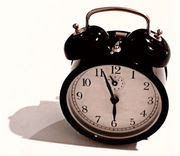
What Does Daylight Savings Time Save?
The United States is starting "daylight savings time" (summer time) some weeks early this year, and will continue it longer in the autumn. (Canada is forced to follow suit -- sorry.)This change was decreed by the "Energy Policy Act of 2005" (pdf here; html here). Besides the $2.2 billion in direct spending this act handed out (estimated over its first 5 years by the Congressional Budget Office) and the $7.9 billion in tax breaks it authorized over the same period, Congress in its wisdom decided to do something about energy independence and global warming by adding an additional month of daylight savings time.
Nearly every statement by a politician about this change included these words: "will save the equivalent of 100,000 barrels of oil a day." (See the 2005 Energy Conference Report pdf, or the press release of Congressman Fred Upton [R-Michigan], who introduced this provision).
This figure comes from a study done by the Department of Transportation in the '70s. I can't find the original study, but it was quoted in testimony of then-acting deputy assistant secretary for transportation policy Linda Lawson before House Science Committee in 2001. Her testimony in part:
I want to note that these studies are over 25 years old and were limited in scope. Congress captured many of the benefits identified in our studies in the legislative changes to daylight saving time enacted in 1986. There have been dramatic changes in lifestyle and commerce since we completed our studies that raise serious questions about extrapolating conclusions from our studies into today’s world.But apparently Congress focused on the "equivalent of 100,000 barrels" and extended daylight savings time. Note that 100,000 barrels is 0.5% of daily petroleum consumption in the U.S. In fact saving electricity doesn't save much oil, since most electricity is generated with coal or natural gas. Daylight savings time can have no real impact on oil imports.
. . .
Let me now briefly summarize the technical findings regarding daylight saving time benefits. The studies are over twenty-five years old and have not been updated.
Our 1975 study concluded that daylight saving time might result in electricity savings of 1 percent in March and April, equivalent to roughly 100,000 barrels of oil daily over the two months. These savings were calculated from Federal Power Commission data for only four daylight saving time transitions -- in the winter, spring and fall of the 1974 - 1975 experiment. Due to the limited data sample, the findings were judged "probable", rather than conclusive. Theoretical studies of home heating fuel consumption identified small savings due to daylight saving time. No potential increases in travel demand and gasoline use due to daylight savings time were identified at that time. The lack of actual data precluded an estimation of net daylight saving time energy savings.
. . .
Before making changes to daylight saving time, we urge the Congress to consider the costs and benefits of such changes. As I have noted, DOT’s studies are over 25 years old. New studies must consider impacts on uniformity, impacts on coordination of transportation and commerce, impacts on transportation safety, and net energy impacts. The studies must consider the impact of changes on electrical lighting use, heating energy use, air conditioning use, and transportation energy use, including the potential for increased travel demand resulting from more evening daylight and increased gasoline use.
No Real Savings
More recent studies find very slight and uncertain savings, or none at all.Does Extending Daylight Saving Time Save Energy? Evidence From an Australian Experiment by Ryan Kellogg and Hendrik Wolff, January 2007:
Given the economic and environmental imperatives driving efforts to reduce energy consumption, policy-makers are considering extending Daylight Saving Time (DST). Doing so is widely believed to reduce electricity use. Our research challenges this belief, as well as the studies underlying it. We offer a new test of whether extending DST decreases energy consumption by evaluating an extension that occurred in the state of Victoria, Australia in 2000. Using half-hourly panel data on electricity consumption and a triple-difference treatment effect model, we show that, while extending DST does reduce electricity consumption in the evening, the increased demand in the morning cancels this benefit out. We statistically reject electricity savings of 1% or greater at a 1% significance level.Electricity Savings From Early Daylight Saving Time by Adrienne Kandal, February 2007:
There is no clear evidence that electricity will be saved from the earlier start to daylight saving time on March 11, but the 7 p.m. peak load will probably drop on the order of 3% for the remainder of March, lowering capacity requirements. This could be negated by a new morning spike as it was in Australia in 2000, but that appears unlikely. In any event, capacity constraints usually do not occur in March and early November.
. . .
In summary, it seems very likely that our peak load will drop in the evening, possible that we will save a fraction of a percent of total electricity use, and possible but not very likely that we will see a morning electricity spike that would negate evening savings. Still, California might want be prepared for a possible morning mini-peak as it makes forecasts for electricity needs. Victoria’s failure to prepare for its morning peak caused morning price spikes.
Moral:
Politicians want to be seen to be doing something about energy problems, but don't seem to care if their actions really help or not. If we want something done, we will have to do it ourselves.These posts are thoughts that have occurred to us here at GCF Associates and Global Climate Fund. Feel free to contact us if you have any questions or ideas for future posts.


No comments:
Post a Comment